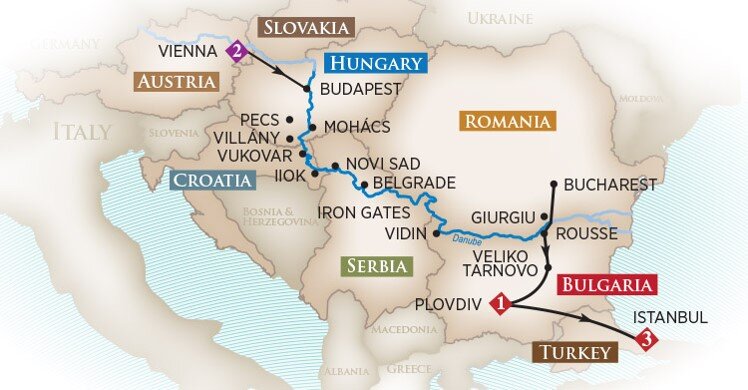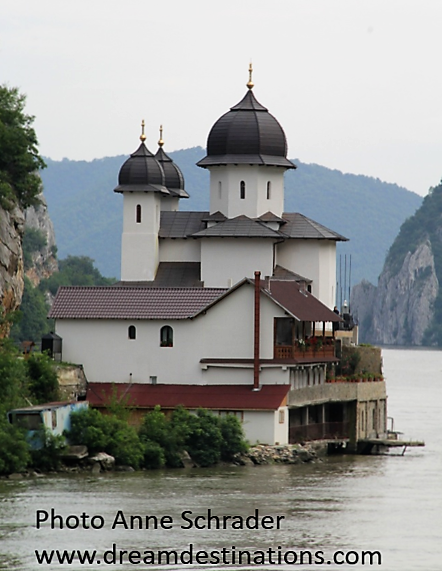The Lower Danube River Cruise Route
By Hank Schrader, USMA ’71, Europe Destination & Europe River Cruise Expert
The Danube is 1,170 miles, making it the second longest river in Europe after the Volga River in Russia. This is a river of legends; serves as a borderline between countries; has four capital cities on or near its banks and romantic sights of medieval castles, baroque churches and abbeys and rococo palaces. There are 2 routes here. The upper portion is primarily in Austria and Hungry. The lower segment is in the Balkans.
The lower Danube is the gateway to Eastern Europe. This segment begins in Budapest and ends near the Black Sea. It starts with the rolling hills and vine-clad slopes of the Pecs in Hungary; then moves to the boundary waters that separate Serbia and Croatia; then traverses the narrow gorges of the Iron Gates, a stunning passage that divides the Balkan and Carpathian Mountains and either ends in Bucharest, Romania or at the Black Sea.
The Lower Danube River Cruise Route. Photo from AmaWaterways
Why Go on this Route?
This is a unique chance to visit some lesser known areas of Europe. Since these countries are not part of the Schengen area, it is much easier to visit on a river cruise—border formalities and many money issues are handled for you.
We enjoyed this trip, the friendly people and learning about new areas. We aren’t alone—here is an opinion from one of our great clients:
“What a great trip! I am an experienced traveler, have traveled all over the world, and this is the best trip I ever had! To be able to see 8 countries, explore a many venues and participate in a multitude of events created a unique vacation I will never forget. The food, wine, staff and overall experience was awesome! It allowed me to make a whole new set friends. I want thank my professional travel team of Hank and Anne for helping me make it possible.
— Jeff R Danube Cruise (lower and upper 2018) on the AmaCerto”
Jeff and Hank on the AmaCerto 2018
Pretty good reasons to go explore this region, don’t you think so!
The Ports
Budapest, Hungary
All routes either start or end in Budapest. It is the most interesting and beautiful city on the Danube route. It is really two cities linked by the Chain Bridge. The Pest side was the former home of the Royals and Buda Castle and Fisherman’s Bastion are two great places to visit.
Buda Castle. Photo Anne Schrader
Fisherman’s Bastion, Budapest
On the Pest side, my favorites are the Parliament Building and the Great Market. It is worthy of a couple of days or more.
Great Market on the Pest side
Budapest Parliament at night
Pecs, Hungary
Pecs is a city of art and history. It is the 5th largest city in Hungary. It first was a Roman city called Sopianae. The Hungarians conquered the area in the late 9th century. In the Middle Ages, Pecs was a center of learning and education. It was conquered by the Turks in 1543. When the Turks were expelled (they ruled for about 150 years), it became part of the Habsburg Empire. It has the largest Turkish ruins in Hungary. It is also famous for Zsolnay ceramics.
Here are some photos:
Watch Tower of the Old Fort in Pecs Hungary
Fountain with Zsolnay porcelain spigots in Pecs Hungary
Building in Pecs, Hungary
Vukovar, Croatia
This is a somber stop on a Lower Danube cruise, as Vukovar is the only town since WW II that was almost completely destroyed during the Kosovo War in 1991. Vukovar held out for 3 months against an overwhelming Serbian force and many of the residents were killed.
Cross on the Danube—a tribute to all who gave their lives for a free and independent Croatia
The war sights are the main stops here. The cemetery is quite moving.
Memorial statue in the Vukovar Cemetery. The statue has a symbolic flame at its center, and the stones present the image of the Christian cross facing outward in all directions.
Eltz Manor Museum is the other main tourist site.
Eltz Manor Museum
Novi Sad
Novi Sad is the 2nd largest city in Serbia. As with many places on the Lower Danube, the Ottoman Turks controlled this town for about 150 years (from 1526 to1687) and then it became part of the Habsburg Empire. Later, it was part of Yugoslavia, then a separate country and was bombed during the Kosovo War. It is now part of the Republic of Serbia.
The Petrovaradin Fortress is the best known landmark in the area. Novi Sad is also considered the cultural capital of Serbia. It has an interesting main square; the exquisite Bishop’s Palace and plenty of colorful wall paintings.
Here are some photos:
Petrovaradin Fortress Novi Sad, Serbia
Petrovaradin Fortress Clock Tower
Town Hall, Novi Sad
Bishops Palace Residence, Novi Sad. Serbia
Colorful Mural, Novi Sad, Serbia
Belgrade, Serbia
Belgrade is Serbia’s capital.
The two key sights here are the Kalemegdan Fortress and the Serbian Orthodox Church of St. Sava.
The fortress, on the banks of the Sava River and the Danube River is huge and once protected an entire city inside its walls. Today it is just a park to stroll through with displays of armaments in the Belgrade military museum, Ruzica Church, the zoo, and the observatory and planetarium.
Kalemegdan Fortress Walls
Part of the Outside display of Belgrade Military Museum
St. Sava Cathedral is the largest Orthodox Church in the Balkan region and the 2nd largest in the world. Its’ dome is 70 meters high with a 12 meter cross on top, has 50 bells and 18 golden crosses. It can hold 10,000 (all standing—there are no pews) and work continues on the inside with mosaics. It represents faith and freedom to the Serbian people.
St. Sava Orthodox Cathedral
A mosaic inside the St. Sava Cathedral
Knez Mihailova Street-- is the main pedestrian and shopping zone in Belgrade, and is protected by law as one of the oldest and most valuable landmarks of the city. It features a large number of impressive buildings and mansions built during late 1870s.
One of the ornate buildings on Knez Mihailova Street
Princess Ljubica’s Palace—this palace was supposed to be the lavish seat for the Serbian Court, but warfare with Turks prevented it. Today it is a museum with a series of lavishly furnished rooms.
Outside of Princess Ljubica’s Palace
The National Assembly of Serbia—this perhaps is the most photogenic building in Belgrade. It used to be the home of Yugoslavia’s Assembly.
The National Assembly of Serbia
Iron Gates
The Iron gates is one of the most scenic cruise routes in all Europe.
The Danube narrows into an impressive series of gorges between the mountain ranges of the Carpathian and Balkan Mountains.
The rugged cliffs of the Iron Gates on the Lower Danube River
The banks of the river along this natural border between Serbia and Romania are lined with sheer-faced rocks that stretch high overhead
A convent Orthodox Church in the Iron Gates
One of the favorite sights is the rock carving of Decebalus (the last king of Dacis, who fought against the Roman emperors Domitian & Trajan to preserve the independence of his country, which corresponded to modern Romania). He gazes down at passengers as they cruise the Iron Gates towards Vidin.
The rock carving of Decebalus
Vidin, Bulgaria
Located in the northwest corner of Bulgaria, Vidin is known as the “The Danube’s Eternal Guardian.”
Baba Vida Castle
The best known site is the Baba Vida Castle. This well preserved castle is fun to visit and tour.
A great view showing how the fort could defend the Danube Waterway
Legend says that Vida (daughter of a wealthy Bulgarian Boyar), due to the unsuccessful marriages of her sisters, rejected all proposals for marriage and built the castle to protect Vidin and remained there for the rest of her life.
Baba Vida Statue
Vidin is the gateway to Belogradchik (about 50 km away), a hill town that has gigantic pillars of rust colored sandstone rocks and a fortress.
Here are some photos:
Belogradchik Rocks
The fort at Belogradchik rocks area
Bucharest, Romania
Bucharest is known as the “Paris of the East.
We first visited to the Open Air Museum, dedicated to preserving the traditional architecture of rural Romania.
Open Air Museum Bucharest, Romainia
Open Air Museum Bucharest, Romainia
The most impressive site in Bucharest is the Palace of the Parliament only for its sheer size—it is the second largest building in the world after the Pentagon.
Palace of the Parliament
Another great stop is a tour or walk in the newly renovated Lipscani district, the historical center of Bucharest.
Vlad (Dracula) statue in Lipscani district, the historical center of Bucharest.
Ruins of the Old Courtyard in the Lipscani district, the historical center of Bucharest.
Annunciation Church of Saint Anthony Lipscani district Bucharest
Pre/Post Cruise Extensions
Brasov—a great place for a pre or post stay. It is a chance to see what a Transylvanian old city looked like. It is also a good gateway to Braun Castle (14 century) a military outpost controlling the entry route to Transylvania and nowadays is associated with the myth of Dracula.
Old Gate entrance to Brasov, Romania
I would also try to visit Peles Castle (built from 1873 to 1914) the former summer residence of the Romania Royal Family. I recently wrote about this fabulous structure in our 33 Palaces of Europe blog. It is the most visited museum in Romania.
Braun Castle
Braun Castle Courtyard
Peles Castle Arms Room
Istanbul—the European portion of Istanbul is one of the most fascinating and interesting cities in the world. It is offered as a possible post stay to your cruise.
My three favorites were the Topkapi Palace, the Hagia Sophia and the Spice Market.
Tokapi Palace
Mural inside the Hagia Sophia
Spice Market Istanbul
This is a city worth several days and is another unforgettable experience.
My Final Thoughts
This is a chance for folks to explore a part of Europe that once was part of the Communist Block. It is a world many haven’t seen but it is special. A turbulent history of war and conflict has shaped this area but it has a lot to offer.
We highly recommend this cruise.
When you are spending your hard-earned money for a vacation, you want an advisor who can match you with the right trip. You want someone who will understand your expectations and fuel your anticipation (or excitement) to get you the best possible trip experience. And, you want someone who can help you with the decision making process. We think we have all these qualities.
Whatever your Dream Destinations are, we are here to help you get the best possible vacation based on what is important to you! We will provide you high quality, expertly planned travel. Please give me a call 713-397-0188 (Hank) or email me at hschrader@dreamdestinations.com. We want to help you: Savor life…make memories…Visit Dream Destinations! Your journey begins here!
HANK is a certified Western European Destination Specialist (DS) who has been traveling to Europe for 49 years. He is also an Accredited Cruise Counselor (ACC), conferred by the Cruise Line International Association (CLIA). This recognized expert in cruise and leisure travel is a retired Army Officer, and taught World Geography for 8 years. He is a `71 graduate of West Point and has earned 2 master’s degrees. His other Certifications:
AmaWaterways River Cruise Specialist
Viking River Cruise Specialist
Scenic River Cruise Specialist
Emerald Waterways Specialist
Avalon Waterways Specialist
Brit Agent



















































